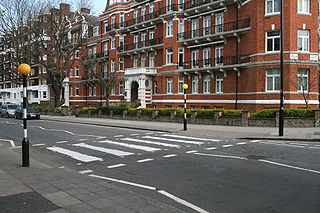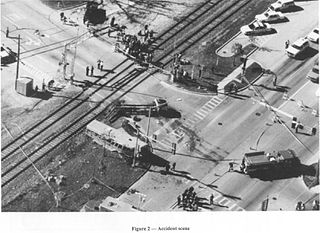
Traffic on roads consists of road users including pedestrians, ridden or herded animals, vehicles, streetcars, buses and other conveyances, either singly or together, while using the public way for purposes of travel.

A ramp meter, ramp signal, or metering light is a device, usually a basic traffic light or a two-section signal light together with a signal controller, that regulates the flow of traffic entering freeways according to current traffic conditions. Ramp meters are used at freeway on-ramps to manage the rate of automobiles entering the freeway. Ramp metering systems have proved to be successful in decreasing traffic congestion and improving driver safety.

An intersection is an at-grade junction where two or more roads or streets meet or cross. Intersections may be classified by number of road segments, traffic controls or lane design.

A pedestrian crossing or crosswalk is a place designated for pedestrians to cross a road, street or avenue. Pelican crosswalks are designed to keep pedestrians together where they can be seen by motorists, and where they can cross most safely across the flow of vehicular traffic.

Traffic lights, traffic signals or robots are signalling devices positioned at road intersections, pedestrian crossings, and other locations to control flows of traffic.

Traffic engineering is a branch of civil engineering that uses engineering techniques to achieve the safe and efficient movement of people and goods on roadways. It focuses mainly on research for safe and efficient traffic flow, such as road geometry, sidewalks and crosswalks, cycling infrastructure, traffic signs, road surface markings and traffic lights. Traffic engineering deals with the functional part of transportation system, except the infrastructures provided.
A Controller Area Network is a robust vehicle bus standard designed to allow microcontrollers and devices to communicate with each other's applications without a host computer. It is a message-based protocol, designed originally for multiplex electrical wiring within automobiles to save on copper, but can also be used in many other contexts. For each device the data in a frame is transmitted sequentially but in such a way that if more than one device transmits at the same time the highest priority device is able to continue while the others back off. Frames are received by all devices, including by the transmitting device.

The 1995 Fox River Grove bus–train collision was a grade crossing collision that killed seven students riding aboard a school bus in Fox River Grove, Illinois, on the morning of October 25, 1995. The school bus, driven by a substitute driver, was stopped at a traffic light with the rearmost portion extending onto a portion of the railroad tracks when it was struck by a Metra Union Pacific / Northwest Line train en route to Chicago.
Signal timing is the technique which traffic engineers use to distribute right-of-way at a signalized intersection. The process includes selecting appropriate values for timing which is implemented in specialized traffic signal controllers. Signal timing involves deciding how much green time the traffic signal provides to an intersection by movement or approach, how long the pedestrian WALK signal should be, whether trains or buses should be prioritized, and numerous other factors.
Traffic signal preemption is a type of system that allows the normal operation of traffic lights to be preempted. The most common use of these systems is to manipulate traffic signals in the path of an emergency vehicle, halting conflicting traffic and allowing the emergency vehicle right-of-way, to help reduce response times and enhance traffic safety. Signal preemption can also be used by light-rail and bus rapid transit systems to allow public transportation priority access through intersections, or by railroad systems at crossings to prevent collisions.

The use of traffic lights to control the movement of traffic differs regionally and internationally in certain respects. This article describes some of these non-universal features. Note that the color phase commonly known as "yellow" is often referred to, especially in official usage, as "amber"; for consistency this article uses "yellow" throughout.
The Sydney Coordinated Adaptive Traffic System, abbreviated SCATS, is an intelligent transportation system that manages the dynamic timing of signal phases at traffic signals, meaning that it tries to find the best phasing for a traffic situation. SCATS is based on the automatic plan selection from a library in response to the data derived from loop detectors or other road traffic sensors.
Lost time is the term within traffic engineering for the time during which no vehicles are able to pass through an intersection despite the traffic signal displaying a green (go) signal. The total lost time is the sum of two separate elements: start-up lost time and clearance lost time. Start-up lost time happens when a traffic signal changes from red (stop) to green (go). Some amount of time elapses between the signal changing from red to green and the first queued vehicle moving through the intersection. There is then an additional amount of time for the next vehicle to begin moving and pass through the intersection, and so on. The total time taken for all waiting drivers to react and accelerate is the start-up lost time. Clearance lost time is the time lost to stopping a line of vehicles at the end of a green phase. Lost time is always measured in seconds.
A traffic signal operations specialist (TSOS) is a certification sponsored by the Transportation Professional Certification Board, Inc., and promulgated by the Institute of Transportation Engineers. Before taking the prerequisite examination, an individual must have at least five years of related working experience, though relevant education or training may be applied toward this requirement. TSOS certification does not substitute for appropriate professional licenses when required for specific responsibilities or jurisdictions.

A queue jump is a type of roadway geometry used to provide preference to buses at intersections, often found in bus rapid transit systems. It consists of an additional travel lane on the approach to a signalised intersection. This lane is often restricted to transit vehicles only. A queue jump lane is usually accompanied by a signal which provides a phase specifically for vehicles within the queue jump. Vehicles in the queue jump lane get a "head-start" over other queued vehicles and can therefore merge into the regular travel lanes immediately beyond the signal. The intent of the lane is to allow the higher-capacity vehicles to cut to the front of the queue, reducing the delay caused by the signal and improving the operational efficiency of the transit system.

MetroLink is Halifax Regional Municipality's BRT express bus service, operated by Halifax Transit.

The normal function of traffic lights requires more than slight control and coordination to ensure that traffic and pedestrians move as smoothly, and safely as possible. A variety of different control systems are used to accomplish this, ranging from simple clockwork mechanisms to sophisticated computerized control and coordination systems that self-adjust to minimize delay to people using the junction.
Scalable Urban Traffic Control (Surtrac) is an adaptive traffic control system developed by researchers at the Robotics Institute, Carnegie Mellon University. Surtrac dynamically optimizes the control of traffic signals to improve traffic flow for both urban grids and corridors; optimization goals include less waiting, reduced traffic congestion, shorter trips, and less pollution. The core control engine combines schedule-driven intersection control with decentralized coordination mechanisms. Since June 2012, a pilot implementation of the Surtrac system has been deployed on nine intersections in the East Liberty neighborhood of Pittsburgh, Pennsylvania. Surtrac reduced travel times more than 25% on average, and wait times were reduced an average of 40%. A second phase of the pilot program for the Bakery Square district has been running since October 2013. In 2015, Rapid Flow Technologies was formed to commercialize the Surtrac technology. The lead inventor of this technology, Dr. Xiao-Feng Xie, states that he has no association with and does not provide technology supports for this company.

The King Street Transit Priority Corridor is a transit mall located along King Street between Jarvis and Bathurst Streets in Toronto, Ontario, Canada. It passes by two subway stations on Line 1 Yonge–University. The corridor was created by the King Street Pilot Project to improve streetcar reliability on downtown King Street. The corridor went into operation on November 12, 2017, and was made permanent by City Council on April 16, 2019. The corridor is 2.6 km (1.6 mi) long and spans 18 street intersections.












